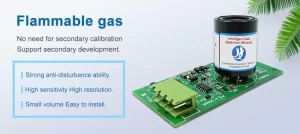Air pollution has become a global concern, affecting the health and well-being of millions of people worldwide. To address this issue, innovative technologies are being developed to revolutionize air quality monitoring systems. Among these technologies, gas sensors play a pivotal role in detecting and analyzing air pollutants, enabling effective environmental protection measures. This article explores the significant role of gas sensors in revolutionizing air quality monitoring and their contribution to safeguarding the environment.
Understanding Gas Sensors:
Gas sensors are electronic devices designed to detect and measure the concentration of various gases present in the atmosphere. They work on the principle of chemical reactions, converting the target gas molecules into an electrically measurable signal. Different types of gas sensors, such as electrochemical sensors, metal oxide sensors, and infrared sensors, are used to detect specific gases with high sensitivity and accuracy.
Real-time Air Pollution Monitoring:
Gas sensors enable real-time monitoring of air pollution levels, providing valuable insights into the quality of the ambient air. By continuously measuring the concentration of harmful gases like carbon monoxide (CO), nitrogen dioxide (NO2), ozone (O3), and particulate matter (PM), gas sensors facilitate the identification of pollution sources and the assessment of their impact on human health and the environment. Real-time monitoring allows for prompt actions to be taken in case of high pollutant levels, ensuring better air quality management.
Industrial Applications:
Gas sensors find extensive applications in various industries to monitor and control emissions. In factories and manufacturing plants, gas sensors play a critical role in maintaining safe working conditions by detecting toxic or combustible gases. By continuously monitoring the emission levels from industrial processes, gas sensors help in identifying potential leaks or malfunctions, preventing accidents and minimizing environmental pollution.
Indoor Air Quality Control:
Indoor air pollution is a significant concern, considering that people spend a significant amount of time indoors. Gas sensors enable the monitoring and control of indoor air quality by detecting gases such as carbon dioxide (CO2), volatile organic compounds (VOCs), and formaldehyde. By providing real-time data on indoor air pollutants, gas sensors help in implementing effective ventilation strategies, reducing health risks, and creating healthier living and working environments.
Smart Cities and Environmental Sustainability:
The integration of gas sensors into smart city infrastructure plays a crucial role in environmental sustainability efforts. Gas sensors deployed throughout urban areas can continuously monitor air pollution levels and provide real-time data to city authorities. This data helps in making informed decisions regarding traffic management, urban planning, and policy-making to mitigate pollution and improve overall air quality.
Advancements in Gas Sensor Technology:
Gas sensor technology has witnessed significant advancements in recent years. The miniaturization of sensors, increased sensitivity, and improved selectivity have enhanced their performance and reliability. Additionally, wireless connectivity and internet of things (IoT) capabilities enable seamless data transmission and remote monitoring of air quality, enhancing the efficiency of environmental protection measures.
Future Prospects and Challenges:
The future of gas sensors looks promising, with ongoing research and development aiming to further enhance their accuracy, response time, and versatility. Emerging technologies, such as artificial intelligence and machine learning algorithms, will enable more sophisticated data analysis, pattern recognition, and prediction models for early detection of air pollution trends. However, challenges such as calibration, maintenance, and cost-effective deployment of gas sensors on a large scale need to be addressed for their widespread implementation.
Conclusion:
Gas sensors have revolutionized air quality monitoring, playing a crucial role in environmental protection. Through real-time monitoring, they provide valuable data for decision-makers to take proactive measures and mitigate the impact of air pollution on human health and the environment. With continuous advancements in gas sensor technology, we can expect more accurate and reliable monitoring systems that will contribute to a healthier and sustainable future. It is imperative to continue supporting research, development, and implementation efforts to harness the full potential of gas sensors in safeguarding our environment.
 : +86 155 8830 2704
: +86 155 8830 2704 : jxdziot@gmail.com
: jxdziot@gmail.com
